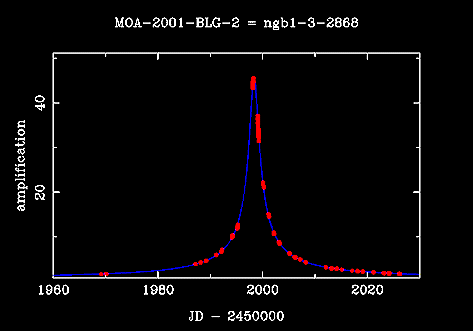MICROLENSING ALERTS
The brevity and non-repeatability of microlensing events requires all possible information to be obtained on them whilst they are in progress. As a consequence of this, microlensing groups issue ‘alerts’ of events in progress in order that they may be monitored by other observatories around the globe. This practice was introduced by the pioneering groups in the field, MACHO, EROS and OGLE, and is presently being continued by the OGLE and MOA groups.
Alerts issued by the MOA group can be found at MOA Microlensing Alerts for the current year and for reference the previous Alerts 2000-2006.
A typical events is shown below
 |
Light curve of a microlensing event MOA 2001-BLG-02. The blue line is the theoretical light curve (B. Paczynski, Astrophysical Journal, Vol. 304, p. 1) and the red dots are the measurements. A network of telescopes circling the globe is needed to obtain a continuous light curve. Such a light curve can yield valuable information on both the lens and the source stars.
The MOA group uses ‘difference-imaging’ photometry to issue alerts, as described at astro-ph/0102181. This enables events to be found with faint source stars that are undetectable when unmagnified. This not only increases the detection rate of microlensing events, but also enables events to be found in which the source stars are faint, dwarf stars. These events are particularly useful for studies of extra-solar planets orbiting the lens star as described at astro-ph/0111041.
